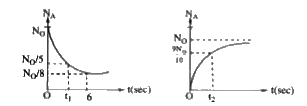A nucleus .A. decays into .b. with half life .T1. and B decays into .C. with half life T2, Graphs are drwan between number of atoms/activity versus time which are as shown, then

BC are correct
ABC are correct
AD are correct
BCD are correct
The correct Answer is:C
Step by step video & image solution for A nucleus .A. decays into .b. with half life .T_(1). and B decays into .C. with half life T_(2), Graphs are drwan between number of atoms/activity versus time which are as shown, then by Physics experts to help you in doubts & scoring excellent marks in Class 12 exams.
Topper's Solved these Questions
- BOOK - AAKASH SERIESCHAPTER - NUCLEAR PHYSICSEXERCISE - ADDITIONAL PRACTICE LEVEL-II (LECTURE SHEET (ADVANCED)) More than one correct answer Type Questions )4videos
NUCLEAR PHYSICS
- BOOK - AAKASH SERIESCHAPTER - NUCLEAR PHYSICSEXERCISE - ADDITIONAL PRACTICE LEVEL-II (LECTURE SHEET (ADVANCED)) Linked Comprehension Type Questions Passage-I :)2videos
NUCLEAR PHYSICS
- BOOK - AAKASH SERIESCHAPTER - NUCLEAR PHYSICSEXERCISE - ADDITIONAL PRACTICE EXERCISE (LEVEL-I (MAIN)) (Straight Objective Type Questions)10videos
NUCLEAR PHYSICS
- BOOK - AAKASH SERIESCHAPTER - MOVING CHARGES AND MAGNETISMEXERCISE - EXERCISE-III49videos
MOVING CHARGES AND MAGNETISM
- BOOK - AAKASH SERIESCHAPTER - NUCLEIEXERCISE - Practice Exercise40videos
NUCLEI
Similar Questions
Radioactive nucleus A decays into B with half-life 10sec. A also convert into C with half-life 100sec. Find half-life of A for both emission.
View SolutionNucleus A decays into B with a decay constant λ1 and B further decays into C with a decay constant λ2 . Initially, at t = 0, the number of nuclei of A and B were 3N0 and N0 respectively. If at t = t0 number of nuclei of B becomes constant and equal to 2N0, then
View Solution
Knowledge Check
- Question 1 - Select One
A fraction f1 of a radioactive sample decays in one mean life, and a fraction f2 decays in one half life. Then
Af1>f2Bf1<f2Cf1=f2Deither of (a),(b ) or (c ) depending on the values of the mean life and half life.
Nucleus A decays to B with decay constant λ1 and B decays to C with decay constant λ2. Initially at t=0 number of nuclei of A and B are 2N0 and N0 respectively. At t=to, no. of nuclei of B is 3N02 and nuclei of B stop changing. Find t0?
View SolutionIn a decay process A decays to B. A→B. Two graphs of number of nuclei of A and B versus time is given then
 View Solution
View SolutionObtain a relation between half life of a radioactive substance and decay constant (λ) .
View SolutionA certain substance decays to 1/32 of its initial activity in 25 days. Calculate its half-life.
View SolutionThe half-life of a radioactive decay is x times its mean life. The value of zx is
View SolutionA radioactive nucleus A with a half life T, decays into nucleus B. At t=0, there is no nucleus B. At some time t, the ratio of the number of B to that of A is 0.3 . Then, t is given by
View SolutionThe activity of a nucleus is inversely proportional to its half of average life. Thus, shorter the half life of an element, greater is its radioactivity, i.e., greater the number of atomsd disintegrating per second. The relation between half life and average life is t1/2=0.693λ=τ×0.693
or τ=1.44t1/2
The half life of a radioactive element is 10 years. What percentage of it will decay in 100 years?View Solution

